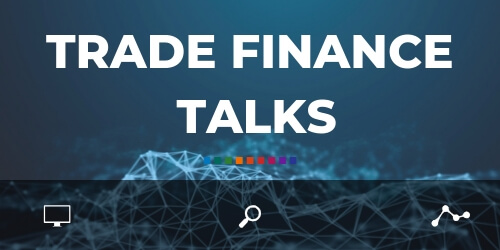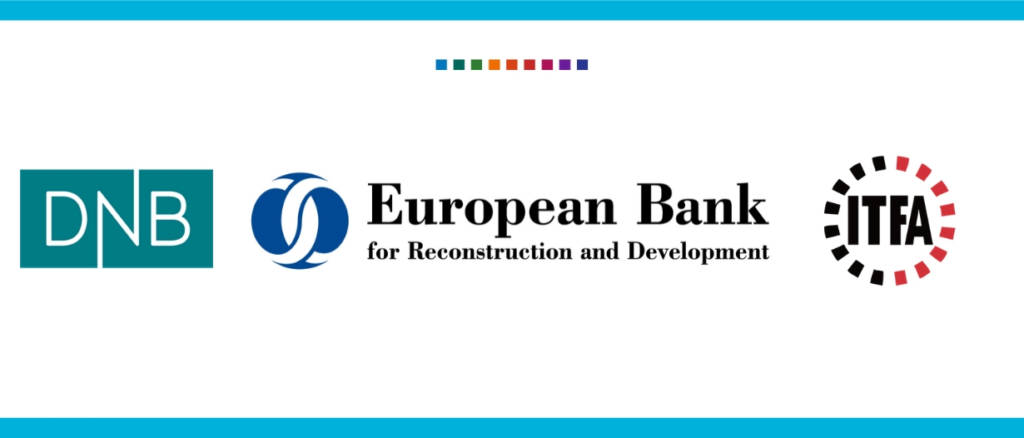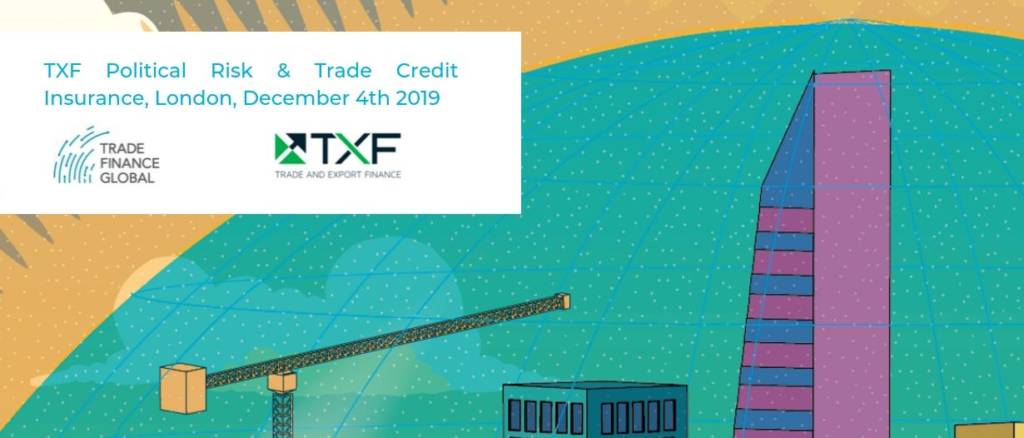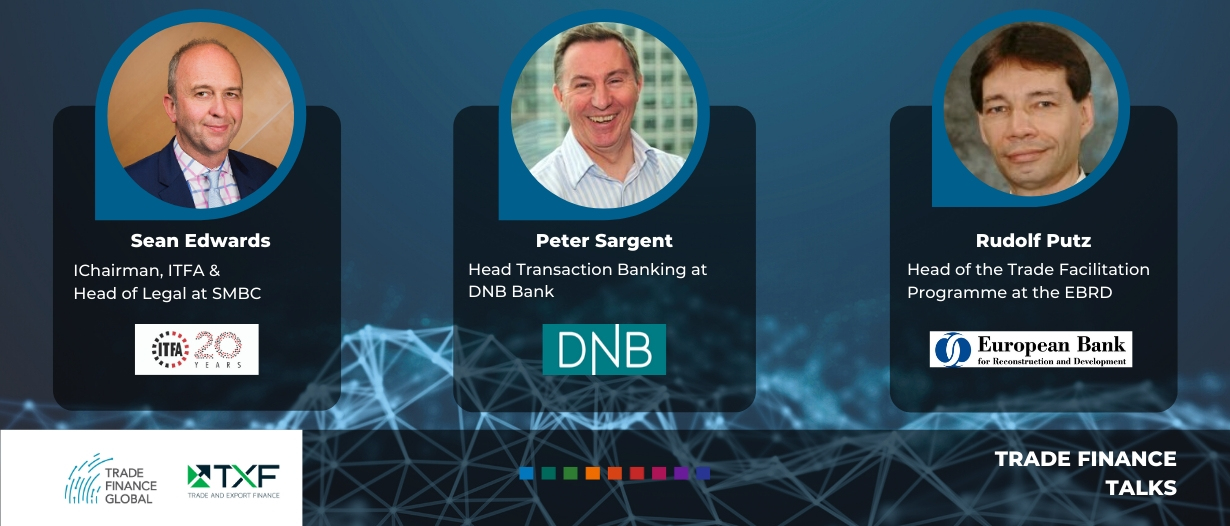Listen to this podcast on Spotify, Apple Podcasts, Podbean, Podtail, ListenNotes, TuneIn, PodChaser
Season 1, Episode 32
Host: Deepesh Patel, Editor, Trade Finance Global
Featuring: Sean Edwards, Chairman, ITFA & Head of Legal at SMBC
Peter Sargent, Head of Transaction Banking at DNB Bank
Rudolf Putz, Head of the Trade Facilitation Programme at the EBRD

TXF Political Risk & Trade Credit Insurance is a uniquely interactive forum where banks, corporates and traders meet the CPRI market to forge new and deeper partnerships for distribution, capital relief and risk mitigation.
TFG are delighted to be Media Partners of the TXF Political Risk & Insurance conference in London on the 4th December, and to ensure you’re up to speed with this ever-changing environment, we caught up with leading experts in CPRI ahead of the conference.

Mark Abrams: I’m Mark Abrams have trade a Trade Finance Global. 2019 continues to be a roller coaster for the credit and political risk insurance market. Capital relief, distribution and credit risk mitigation is different from where it was just 12 months ago. TFG delighted to be media partners of the TXF Political Risk and Insurance Conference in London on the 4th December, and to ensure you speed with this ever-changing environment, we caught up with the leading experts in CPRI, ahead of the conference. Today I’m joined by Sean Edwards, Chairman of ITFA and Head of legal as SMBC, Peter Sargent, Head of Transaction Banking at DNB Bank. Rudolf Putz, Head of the Trade Facilitation Programme at the EBRD. Quite the panel and thank you for joining us on Trade Finance Talks!
Mark Abrams: So in a short elevator pitch and no more than 20 seconds, please can you tell us who you are, where you’re from and what you do? Starting with you, Sean?
Sean Edwards: Okay, so good morning. I don’t know if it’s a great pitch actually because I’m the guy who has three jobs and only gets paid for one. The job I do get paid for his Head of Legal at SMBC as you mentioned Mark, the other job I have within SMBC is as a contributor to the supply chain finance department within our larger trade finance department. The idea there is that I help with structuring and what have you, and the job I really enjoyed the most, of course, is being Chair of the International Trade and Forfaiting Association, which covers a lot of different things including credit risk insurance, and increasingly FinTech and not forgetting our traditional market of short term trade.
Mark Abrams: Thank you very much, Peter?
Peter Sargent: Good morning. I’m Peter Sargent. I am Head of Transaction Banking for EMEA for DNB, the Norwegian bank, and a little bit like Sean, I’m the newest member of the ITFA. So we both have mutual interest there. My aim at the moment is to steer customers away from secured, towards an open account approach to their working capital needs.
Rudolf Putz: Good morning I am Rudolf Putz. I am the Head of the Trade Facilitation Programme for European Bank for Reconstruction and Development, and under our Trade Facilitation Programme for EBRD supports the development of trade finance in EBRD’s countries of operation – in Eastern Europe for CIS, and for Southern and for Eastern Mediterranean countries.

Peter Sargent, Head of Transaction Banking, CEMEA, DNB Bank
Sean Edwards, Chairman, ITFA & Head of Legal EMEA, SMBC
Rudolf Putz, Head of Trade Facilitation Programme, European Bank for Reconstruction and Development (EBRD)
Jonathan Parfitt, Director Origination, Corporate & International Banking, ABN
Jérôme Pezé, CEO and Founder, Tinubu Square
Mark Abrams: Sean at SMBC, and having a background as a lawyer, similar to myself, you understand the complex structural and security issues around this changing landscape. Are you seeing a change in sectors being financed and structures being requested?
Sean Edwards: Well, it would be nice to think that we have a future as inventors of complex and very expensive structures actually funnily enough rather like deceptively easy book to read, the demand for most types is to have structures that are straightforward and simple and that paradoxically can actually be sometimes quite hard to structure. So if I look, let’s take Supply Chain Finance first, for example, on the receivables and I’ll divide into receivables and payables. On the receivables side, it’s remaining a lot more traditional, where the changes are coming there are from the FinTechs, actually, they are platformising some of this business, commoditising it a lot more, and the banks need to compete with that to some extent. In some cases, of course, they’re the conduits – the originators of that kind of flow for the platforms. So for the moment, it’s a fairly mutually beneficial relationship. But those structures tend to be fairly straightforward.
On the payable side. So there we’ve seen a lot more change – a party that’s been driven by some controversies that have been raised by the rating agencies, and quite a lot of lack of clarity around the accounting treatment for some of these structures. And what we’re finding there increasingly, especially at SMBC is that for us, even as a global bank, this payables finance or what some people call reverse factoring is dominated by the high volume end. It’s dominated by a couple of the big banks, Citi, Bank of America, and so on. We’ve got huge platforms to do this sort of business. And you do put in place these sorts of arrangements for some of the world’s biggest corporate buyers. So what we’re having to do and if we’re doing it our level, I’m sure it’s even more difficult for some of the smaller banks, is actually to find niche opportunities. So we’re structuring deals, to give people advantages and benefits beyond the traditional ones associated with payables finance, which is normally ensuring the security of your supply chain, making sure that your suppliers have access to lower-priced finance and we’re having to go into really the balance sheets of our customers, the buyers, and find where their pain points are and deal with those. So we’ve done one deal recently with a satellite manufacturer where we managed to push out face payable outstanding from three months to three years. And that was because there was an issue with OPEX, which meant they had a very large OPEX budget, it was payable, it was very chunky and very short-dated, they needed to move that out. So we managed to do that’s where we’re seeing for us the opportunities. For the market more generally, and within ITFA, it’s a bit of a split between people like ourselves, trying to find those opportunities, and people who are trying to go for the big commodity business, again, by commodity, I mean commoditised business, the flow business, that is again for the smaller banks being facilitated by Fintechs because they can do that now much more easily than they ever could. So you don’t have to be at Citi Bank now to have actually a pretty good tech platform. But you do need the clients, so that’s difficult. On the bank to bankside again, what we find, and I know we’re going to talk about this later, is banks being very careful about outgoing capital benefits from their lending. So a lot more even on the trade finance side, we’re finding a lot of even relatively short-dated, small-ticket deals being structured to get, for example, NSFR relief. So all banks are being very careful about that.
EBRD’s Digitalisation Agenda

Mark Abrams: And so now we’ll move on to the digitalisation agenda. And Rudolf, I’d like you to talk about digitalization from multilateral development bank perspective. How is EBRD already promoting FinTech programmes that might help correspondent banks reach out to their customers and we heard from EBRD at the WTO Public Forum last month, about EBRD’s app, Klik, please could you explain?
Rudolf Putz: Under our Trade Facilitation Programme, we support our partner banks in the digitization of their trade finance business. And we organise conferences and forums in our countries of operation, mostly in Eastern Europe and in CIS countries but also in the Meditteranean countries. And at these forums, we offer providers of FinTech solutions and technology to present your solution to the applications of the programmes, to our partner banks. And once our partner banks have decided for specific solutions and providers, we provide them with technical assistance, which means we employ consultants and organise training courses for our partner banks. So that they can familiarise themselves with internationally used applications, and become also part of the international network of digitised operations in trade finance.
EBRD’s Trade Facilitation Programme
Mark Abrams: As a confirming bank under EBRD’s TFP, how can technologies such as this, as well as others, help you work with issuing banks to facilitate trade?
Peter Sargent: Thank you, I think there are two things to say about this. The first one is that EBRD is reflecting the move in international trade away from secured terms and perhaps towards open account terms. To do that, to have the ability to move documentation, for example, online makes the environment in which you operate quicker, more accurate, in the sense that it’s more difficult to get the documentation wrong, and easier and more transparent for individuals involved. Now, the second part about that, of course, is to do that you have to have the knowledge. And this is where I think EBRD’s programme comes in particularly well, which is this whole question of training, coaching, mentoring in the international trade environment. And so I would see the online move by EBRD in those two specific environments.
Trends in the Pre-Export Finance Industry
Mark Abrams: Thank you. And let’s move on to the appetite and actually underlying financing structures now. In particular, how have they changed this year? Peter being an industry veteran, do you see much evolution use and demand in the area of pre-export finance and if so, in what industries?
Peter Sargent: I’m not sure I like the phrase industry veteran, that implies I’m ancient! The use of pre-export finance is raw material is against raw materials and largely at the beginning of the supply chain. So I think that one of the things I’ve seen a change in the last 12 months has been that pre-export finance is becoming part of the longer supply chain forms of finance and not as a separate animal by itself. By that for example, if you look at cocoa, for example, there are longer terms now but you can get co-producing countries and you can do that by using pre-export finance. This is all wrapped up in this whole idea of cash conversion cycles and accelerating short term cash flow earned – pre-export finance is seen as part of that and not as a separate animal by itself. And you know, you do have to remember, 90% of firms who go bankrupt go bankrupt because they run out of cash. And that’s what pre-export finance is aiming to try to help us.
Trends in the Insurance Market
Mark Abrams: We’ve certainly seen a change in appetite in some of the TFG Supply Chain Finance lenders, and also programmes we have originated. Sean with your ITFA hat on, have you seen or heard of any changes in appetite within the insurance market?
Sean Edwards: Yeah, I mean, so credit insurance has really been transformative for the trade finance market over the last five years, provided a huge amount of capacity to the banks, but it also means that the banks are looking for their insurance cover to be as efficient as possible, capital-efficient as possible. So credit risk, obviously, number one priority, and that’s taken care of. But there’s a need to evolve those policies in a way which actually is beneficial for the bank, people looking at it from a common-sense point of view. But the driver for this really is again, capital efficiency, Basel efficiency.
Geopolitical Unrest, Trade Wars and the “normal” functioning of the Supply Chains

Mark Abrams: And relating to supply chain insurance on a portfolio basis, for exporters and the effect of trade wars and geopolitical events, such as Brexit on the ability of supply chains to actually function, Rudolf, what effects do you find that trade wars and geopolitical unrest is having on the mid-market financial institutions that you work with?
Rudolf Putz: So far trade wars have not had a strong impact on trade and trade finance in EBRD’s countries of operation, because historically most trade between EBRD’s countries of operations for rest of the world, we are focused on trade between European Union and Eastern Europe and CIS countries and for Mediterranean countries. We have seen that exporters in our countries of operation that had previously exported also to the United States are increasingly also looking for new markets in Asia, Africa or in the Middle East. And they’ve been quite successful in finding these new markets. On the other side, we see increasing imports from Asia, particularly from China, but also from Korea and Japan, which shows that EBRD’s countries of operation become more and more integrated into the international trade. Concerning geopolitical events, there have been some impacts on EBRD’s country’s of operation due to conflict between Russia and Ukraine. But also we have seen some impact on recent events in Turkey and in Lebanon, where we have seen prices increase, and international correspondent banks are becoming more cautious in taking own risk, particularly for longer tenors and larger amounts in Lebanon but also in the Ukraine and in Turkey.
Mark Abrams: Thank you, and what a great update from EBRD and also from a bank perspective on some of the key changes within the CPRI market in 2019. Lots of taking in and a reminder that I’ll be discussing some of these topics with this panel in much more detail in a few weeks time at TXF London on the 4th of December, Sean, Peter and Rudolf, Thank you very much for joining us on Trade Finance Talks. See you on the 4th.




























